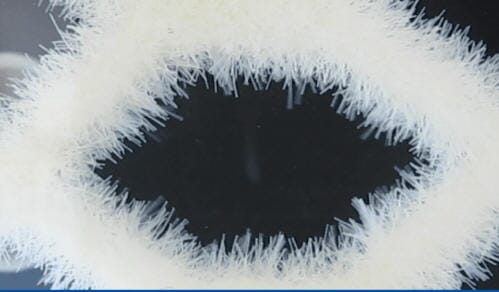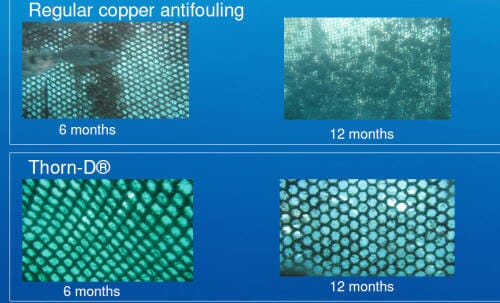Thorn-D was developed by Dr Breur in co-operation with a number of scientific institutes in the EU. It is a non-toxic antifouling that provides a physical barrier for biofouling. By applying very specific short fibers on the surface, the surface becomes prickly and unattractive for fouling organisms to settle.
The first trial of Thorn-D was carried out in 2006 in Turkey. Dr Breur explained that trials took place in Turkey, due to the high amount of sunlight, which increases fouling growth on nets. "If it was going to work well here, it would work well anywhere."
The fouling problem
Biofouling is one of the main concerns while farming fish. It causes the mesh to get blocked, causing lower water exchange levels and a drop in oxygen levels.
Dr Breur said that this could cause lower food conversion ratios and even loss of stock. Hard fouling organisms have sharp edges, therefore netting materials wear out more rapidly. Blocked mesh increases drag, therefore stronger materials are needed and extra balance weight is required to keep the nets in shape.
Because of this biofouling, nets needs to be replaced, cleaned, maintained and redipped in antifouling at least every year, which increases the workload of farm personnel.
Copper-based antifouling products that are currently available are not sustainable, he says. Whilst they work in the short run, they must be constantly maintained and replaced.
How does it work?
Thorn-D is the application of very specific short fibres on the surface of netting. It can be applied on various surfaces includes nets, solid and woven materials.
Instead of killing fouling organisms, Thorn-D prevents organisms from settling on the netting. A combination of prickly and swaying fibres make the surface unattractive for organisms to settle on. There are three different ways in which organisms can settle on the netting.
The first is through single cell attachment. Once a single cell has attached it will multiply, however they are so small that they do not block the mesh, and therefore there is no need for protection. However the swaying motion of the fibres will damage cell structure and cut the threads off after some time.
Larval settlement: The larvae of organisms, such as barnacles, tubeworms and mussels, settle on the surface. Settlement will not lead to stable attachment and juvenile organisms will either die or move away, as the surface isn't smooth.
Spore settlement: Algae show spore settlement. The swaying motion prevents spore sticking, keeping the nets clean.
Image 1 shows the stiff fibres, which prevent organisms from sticking to the netting.

Image 2 compares regular copper antifouling and Thorn-D after six and 12 months. Non-toxic antifouling technology makes surfaces unattractive for organisms to settle on and so last the lifetime of the net.
Image 2 shows that fouling on copper antifouling starts within six months and constantly builds up. Micro-algae is the only fouling that will settle on Thorn-D, therefore in warmer climates, the net can be kept in the water for up to five years.

Thorn D: The benefits
Time cleaning nets: The handling and moving of nets is a potential source of infections and spread of diseases. Due to the extended fouling prevention lifetime of Thorn-D, Dr Breur says that handling and movement of nets is minimised, thus improving the safety of the whole aquaculture operation.
It is also a burden and a cost to handle and treat nets. Dr Breur says that Thorn-D is applied once to new netting, as does not need to be replaced for the lifetime of the net, significantly reducing operational costs.
Costs: Dr Breur says that Thorn-D need only be applied once. He says that despite the initial investment being high, cost savings can be reached within a two-year time period.
Costs are saved as no yearly dipping of nets nor cleaning is required.
Dr Breur estimates that over the five year lifecycle per Nylon net (circumference: 90mtr; height: 20m), Thorn-D costs €35,000, whilst copper antifouling would cost €67,0000.
Environmentally friendly: Copper-based antifoulings are a burden to the environment, said Dr Breur. Thorn-D has a non-toxic physical antifouling principle, which gives an alternative that has no negative effect on the environment. Dr Breur also pointed out that Thorn-D was safer for the fish, as there was little to none skin abrasions and no fibre found in the intestines.
In conclusion, Dr Breur said that Thorn-D allows producers to focus on their core activity: farming fish. It reduces net life-cycle costs, is easy to use and environmentally friendly.


